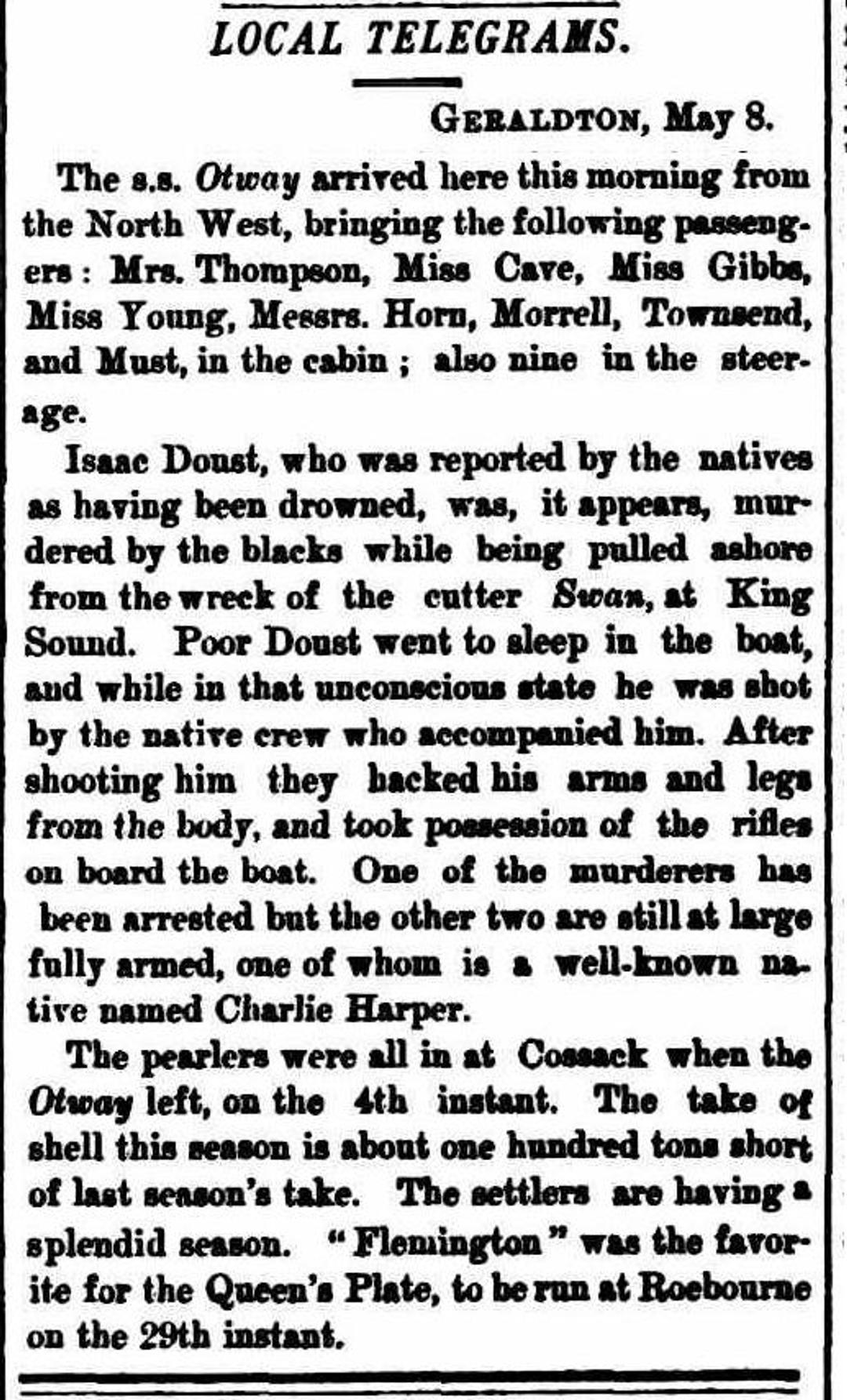Swan 1884
Vessel Name: Swan
Isaac Doust
Likely murdered
April 1884

Newspaper Article, 1884
The Swan was built in Fremantle in 1875, for John Bateman. She was a 26.95 ton, two-masted schooner, built for pearling, in the design that was typical of the day. She measured 14.9 metres and had a draught of 1.8 metres. She was registered in Fremantle as number 4/1875.
Swan was sold to Aubrey Brown and Charles Gill, ship owners, who owned other vessels, including Fairy Queen, which were engaged in the pearling industry in the North West of Western Australia.
The Fairy Queen was exchanging her contracted Aboriginal crew from the Gascoyne, and on 12 August 1875, Swan was carrying fresh divers and crew to Shark Bay for the Fairy Queen. That rendezvous did not occur as Fairy Queen struck a reef at Y Island in the North West Cape.
Swan took the Master, Captain Andrew Edgar, divers and some crew to Tsien Tsin (Cossack) on 18 August 1875. Nine of the Aboriginal crew from Fairy Queen were transferred to the Albert, another pearl boat in the area.
On 23 December 1875, Swan was working the Mary Ann Patch in Exmouth Gulf when a severe cyclone struck the area. Swan parted a chain cable, slipped her anchor and ran into Coolhera Creek and made fast to the mangroves there. She survived the cyclone, while many boats were lost with their crews.
One such unfortunate soul was Charles Gill, one of the co-owners of ill-fated Fairy Queen.
He was aboard Wild Wave when the cyclone struck the east side of the Exmouth Gulf at 5pm. Charles clung to the mast head of Wild Wave for several hours before he drowned, along with Master Watson, two European and 28 Malaysian crew.
Swan was sold on to Isaac Wood, a pearler and stockman.
In 1881, Swan was purchased by Isaac Doust, a pearler who worked the grounds at Cossack. Like the previous crew, Isaac had some lucky escapes aboard Swan. On 7 March 1882, Swan was laying at Hampton Harbour, Cossack when a cyclone struck. Swan was dismasted, but stayed afloat, and was repaired and returned to work.
Early in July 1883, Isaac left Cossack aboard Swan. He took on five Aboriginal crew at Lacepedes Islands, but then was blown off course, and had to beat north. He tried to make land twice, but came into contact with hostile Aboriginals, who drove them away.
On 6 September, the rudder post gave way, and Swan proceeded under head sail. There was fear Swan was lost with all hands, since no other boat sighted her. In Cossack, there was a rumour Isaac had deliberately made Swan disappear to avoid her being seized by debtors. Finally on 18 October, Isaac landed at Port Darwin where she made repairs. Newspapers reported her survival throughout Western Australia.
There are reports of Swan calling into Cape Londonderry, the most northernmost tip of Western Australia. He was reported to have beached at Swan Point to make hull maintenance in April 1884. The next and final stop for Swan was at Sunday Island, north of Broome.
Reportedly, Isaac moored there and went ashore to shoot ducks to supplement their supplies. He weighed anchor at night, and struck a reef, holing the bottom of the boat. Swan stayed on the reef for several days. Isaac was sick and refused to leave his cabin. His crew left and swam the several kilometres to shore. When they arrived in Beagle Bay, they were picked up by the schooner, Kate. They disembarked at Cossack and reported to Police.
Three crew landed in a dinghy near Broome. They were Charley Harper, Sugary and Tommy. They were armed with rifles. A local Aboriginal man found a gun near the dinghy and he reported that Charley Harper, known in the area, had killed Isaac when he was asleep in the dinghy.
The dinghy, with Swan painted on its side, was located floating soon after. One of the rowlocks was stained with blood and some shot was found in the boat.
A conflicting story was told by the crew from Swan. They claimed Swan had sunk near Sunday Island in King Sound. They claimed Isaac had drowned when Swan struck the reef. This was the story that reached the mainland first, and newspapers from all over Western Australia printed the story of Isaac’s murder, once the witness came forward to say Isaac was asleep in his dinghy when he was shot by the men who took the rifles from the boat. He also stated Isaac’s arms and legs were hacked off.
Another conflicting story is that the Swan was wrecked near Stewart Island, off Cape Londonderry. Captain Coghlan RN, on the survey vessel Meda, reported seeing her there. The issue with this story is that Stewart Island is located south of Cossack, while Cape Londonderry is at the northern tip of Western Australia.
Yet another version gave the same impossible location, but named the Black Hawk as the vessel that saw Swan’s wreck. It may be possible those boats saw Swan careened near Swan Point and thought her to be wrecked. It is unlikely Isaac and his crew could have taken their dinghy from Swan Point to King Sound. On 8 May 1884, the Otway berthed in Geraldton from Cossack and the crew reported Isaac was murdered by Aboriginals on Sunday Island.
Arrest warrants had been issued for Charley Harper, and four other crew members from Swan, with a warning they were armed and dangerous. The Revenue Cutter, Eloise, captained by E.B. Mayne, inspector of Pearl Shell Fisheries proceeded to the scene of the murder, but found no trace of Isaac, his dinghy or the two men still at large.
In May 1884, two men were still at large, including Charley Harper. The others were awaiting trial in Roebourne jail. The men were remanded in jail until 14 March 1885, when they were released due to lack of evidence.
Isaac’s body had never been found, and the witness’ story was not corroborated by the crew.
The Aboriginal witness had been taken to Roebourne jail along with the crew, and was detained in prison for over 10 months. Without exercise or medical attention, and limited to the rations allowed for Aboriginal prisoners, he became ill and lost the use of his legs. He was released when the alleged murderers were released, but was returned to his cell when he could not walk and was seen to be extremely unwell. He died in pain within a week.
Not long after the trial, Charles Doust, Isaac’s brother was aboard Rover when she was caught by a sudden squall and foundered at anchor off Point Torment in King Sound. Charles and a Chinese crew member were the only crew aboard, and both drowned in the sinking.
